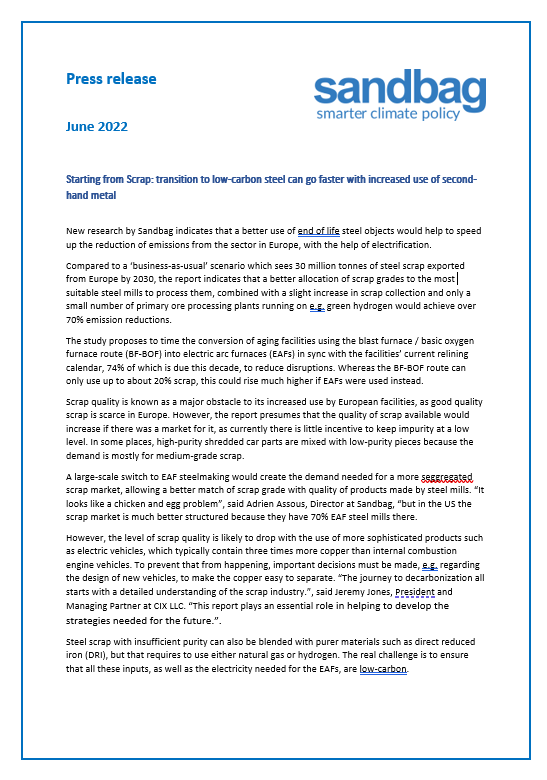Starting from scrap: transition to low-carbon steel can go faster with increased use of second-hand metal
New research by Sandbag indicates that a better use of end of life steel objects would help to speed up the reduction of emissions from the sector in Europe, with the help of electrification.
Compared to a ‘business-as-usual’ scenario which sees 30 million tonnes of steel scrap exported from Europe by 2030, the report indicates that a better allocation of scrap grades to the most suitable steel mills to process them, combined with a slight increase in scrap collection and only a small number of primary ore processing plants running on e.g. green hydrogen would achieve over 70% emission reductions.
The study proposes to time the conversion of aging facilities using the blast furnace / basic oxygen furnace route (BF-BOF) into electric arc furnaces (EAFs) in sync with the facilities’ current relining calendar, 74% of which is due this decade, to reduce disruptions. Whereas the BF-BOF route can only use up to about 20% scrap, this could rise much higher if EAFs were used instead.
Scrap quality is known as a major obstacle to its increased use by European facilities, as good quality scrap is scarce in Europe. However, the report presumes that the quality of scrap available would increase if there was a market for it, as currently there is little incentive to keep impurity at a low level. In some places, high-purity shredded car parts are mixed with low-purity pieces because the demand is mostly for medium-grade scrap.
A large-scale switch to EAF steelmaking would create the demand needed for a more seggregated scrap market, allowing a better match of scrap grade with quality of products made by steel mills. “It looks like a chicken and egg problem”, said Adrien Assous, Director at Sandbag, “but in the US the scrap market is much better structured because they have 70% EAF steel mills there.
However, the level of scrap quality is likely to drop with the use of more sophisticated products such as electric vehicles, which typically contain three times more copper than internal combustion engine vehicles. To prevent that from happening, important decisions must be made, e.g. regarding the design of new vehicles, to make the copper easy to separate. “The journey to decarbonization all starts with a detailed understanding of the scrap industry.”, said Jeremy Jones, President and Managing Partner at CIX LLC. “This report plays an essential role in helping to develop the strategies needed for the future.”.
Steel scrap with insufficient purity can also be blended with purer materials such as direct reduced iron (DRI), but that requires to use either natural gas or hydrogen. The real challenge is to ensure that all these inputs, as well as the electricity needed for the EAFs, are low-carbon.
The policy framework should fit more closely with the needs, which relate more to access to carbon-free electricity and a better structured value chain of used steel products, than support at production plant level.
About Sandbag: a non-profit think tank which uses data analysis to build evidence-based campaigns on climate policy. Sandbag’s research covers industrial decarbonisation, carbon pricing and climate governance in Europe.
About Jeremy Jones: President and Managing Partner of CIX LLC which provides training, advisement and leadership for steel industry professionals from the shop floor level, up to boardroom level. A world expert of EAF steelmaking, he is a regular speaker of the industry’s most prestigious conferences such as AISTech and CRU events. He also contributes to Worldsteel working groups on raw materials and scrap.

